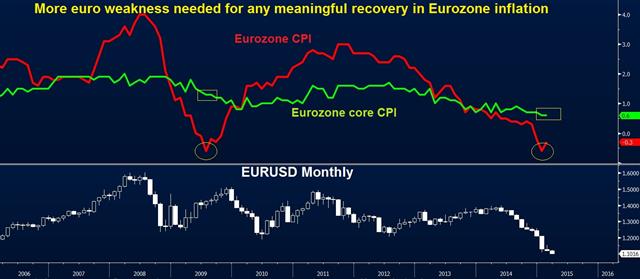Euro hits $1.10 as ECB kicks off QE
The euro currency had short-lived rally off its latest 11-year lows when the ECB revised its 2015 GDP forecasts to 1.5% from December's 1.0% and upgrading its 2016 growth view to 1.9% from the previous 1.5%. Its CPI view for 2015 was lowered to 0% from December's 0.7%, while that for 2016 was lifted to 1.5% from 1.3%. But reality set back in for the euro when ECB president Draghi reiterated the QE program – set to start next week– could be extended beyond its conclusion date of September 2016. More specifically, the currency tumbled after Draghi said asset purchases could extend to bonds with yields as low as -0.20%, which implies that there will be enough bonds covered under the purchase program.
The ECB's monthly spending will include its existing programs to buy covered bonds and asset-backed securities. Of the added purchases, 12% will be debt issued by EU institutions and agencies, with the remainder in sovereign bonds. Buying bonds with maturities ranging from 2 to 30 years. Eligible debt also includes inflation-linked bonds, floating-rate notes and securities with a negative yield.
Unlike the ECB's Securities Markets Program deployed between 2010 and 2012 when the bank purchased bonds without prior notice, this time the purchase of ABS and covered-bond purchases will be undertaken by external asset managers.
The ECB will publish the amounts of sovereign and agency bonds purchased under QE (including maturity and issuer residence) in its monthly report. A maximum of 33% of any country's outstanding debt will be held by the ECB, with less than 25% by bond issue. So far, we know the size of bond purchases will be a function of the ECB's determination of capital key, which is the size of member-nation's economy, with the biggest share going to German bunds, followed by French and Italian bonds.
QE duration
Draghi reiterated QE will run through September 2016 and that it will last until “a sustained adjustment in the path of inflation” toward the ECB's 2.0% inflation target has been reached. With inflation hitting a record low of -0.6% in January, ECB officials are already reiterating the program could be extended beyond September 2016. Another option (not addressed by the ECB) is the possibility of increasing the monthly purchases above the planned €60 bn in the midst of the program.Forward Guidance is the Big Question
The big question remains until when will the ECB become satisfied with price stability? Will the ECB focus on a specific figure such as 1.0%, or 1.5%? Or will it address a formula involving GDP growth, inflation and new loans given by banks selling ABS? The ECB should introduce a new forward guidance related to the macro metrics requiring a change in the pace of bond purchase.When will inflation normalise ?
Leaving forward guidance aside, the major requirement for the ECB to achieve its goal is prolonged euro weakness. With over 2/3 of Eurozone trade taking place inside the 19-member area, the currency pass-through from a falling euro into inflation and higher growth is not as material as that in the US or the UK. It would take a combination of magnitude and duration of euro decline and weakness in order for the currency pass-through to be sustained across imports, consumption and eventually earnings growth.The current 22% decline in EURUSD of the last ten months is comparable in magnitude to that of 2011-2012, 2009-2010 and 2008-2009. The recovery of inflation from its -0.6% lows in July 2009 to 1.9% in Nov 2010 took a little over 12 months, but the trough in core inflation at the time was at +1.3%, compared to the current +0.6%. If the euro starts to rise as soon as inflation ticks higher, then this will present challenges to any sustainable improvement in inflation. Unlike in the CPI recovery of H2 2009 into 2010 when the US dollar was capped by recovering BRICs and renewed QE operations from the Fed, the US currency today is the dominant currency with regards to monetary policy divergence.
This may delay any meaningful euro recovery, while any USD pullbacks from Fed dovishness could present selling opportunities in EURUSD.








